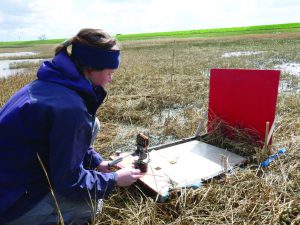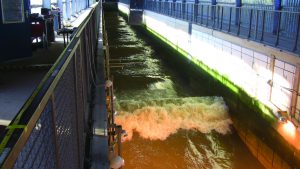Dr Iris Möller – Using Nature to Protect Us From… Nature
Environmental geographer Dr Iris Möller and her colleagues at Cambridge University’s Coastal Research Unit look for ways to protect our coastal areas from flooding by studying the natural protections provided by the coastal geography itself.
Water, Water Everywhere
We all know that three-quarters of the Earth is covered with water. Not surprisingly, 96.5% of it fills our oceans. It follows that there must be lots of land bordering those oceans. In fact, roughly 620,000 km of coastline surrounds the Earth’s seas and over a third of the world’s population, almost 2.4 billion people, live within 100 km of an oceanic coast. After all, who wouldn’t want to watch a sunset over the ocean? Who wouldn’t want easy access to goods and services from far off lands? But going to the seashore to enjoy the sunset is not the same as the seas rushing into the city streets to wreak havoc on the populace. That’s the type of human-ocean interaction that geographer Dr Iris Möller and her colleagues are studying, to find ways to prevent the loss of life and property by encroachment of ocean waters into our human world.
While ocean view property may be attractive, living close to the sea can be perilous. Britons remember the flood of 1953, where over 300 people died as the North Sea surged as far as London. In fact, over 1700 souls perished in the Netherlands from the flooding, due in large part to the lower elevation of that country, much of which is below sea level. More recently, New Orleans and surrounding areas of Louisiana and Mississippi in the US were devastated by Hurricane Katrina in 2005, which killed nearly 1,300 people. Much of New Orleans is below sea level and protected – or at least it was thought to have been protected – by a system of levees and floodwalls. However, some structures failed during the storm surge of Katrina. Besides, the storm surge itself was more intense than it might have been because of subsidence and erosion of the natural wetlands that make up the coastal areas of Southern Louisiana. In retrospect, healthy, vigorous coastal wetlands would have helped to dampen the tidal surge and diminish the flooding of New Orleans from the hurricane. In Louisiana, it seems that the degradation of coastal wetlands, along with old and defective levees and floodwalls, contributed to the loss of hundreds of human lives. This type of scenario is exactly what inspired Dr Möller to get into geography in the first place.
‘I chose geography as my university degree course because I saw how critical our understanding of the connections between people and their environment is for human society, for without such an understanding we cannot continue to exist on our planet. Coasts are particularly interesting in this context,’ Dr Möller tells Scientia. Throughout the time in her career, it became increasingly clear that a rise in sea level and altered climate, altered storminess, altered wave energy and water level fluctuations were all posing an ever-greater threat to populations close to the world’s oceans. She believes that ‘we need to learn to live and cope with these environmental pressures without making them worse by not understanding how our coastal environments help buffer us from their impact.’ This is where she and like-minded colleagues are concentrating their research efforts – looking at our coastal geography and trying to understand how best to use it to protect humankind from the ever-present force of ocean waters. In particular, Dr Möller’s expertise lies in understanding how coastal wetlands help protect the coast from flooding and erosion.

Bringing the Coastline into the Laboratory
It’s difficult to go to where the ocean meets the land and do any meaningful experimentation by trying to modify the land or the waves. After all, how varied is the coast? How unpredictable is the ocean? Forced by highly variable air pressure and winds, water levels and waves can change at very short notice. Atmosphere and ocean are inherently unpredictable beyond the most immediate future, and interesting things often happen when no one is ‘looking’, or rather when researchers are not there recording with their instruments. Data collection for the study of real coastlines and their response to real ocean tides and waves is mostly anecdotal – if you happen to be on site when something happens, you can record it, provided the force of the waves does not destroy your instrumentation (as happened in one of Dr Möller’s research projects on the Baltic sea shore in a winter storm surge). What other option is there? Bringing the coastline into the laboratory for controlled experimentation is similarly challenging. But that’s exactly what Dr Möller and her colleagues did. They constructed a model of the coastline – specifically of a 200-square metre patch of marsh – indoors!
Together with the University of Hamburg, Deltares (a Dutch research organisation), and the Royal Netherlands Institute for Sea Research (NIOZ), Dr Möller’s Cambridge Coastal Research Unit team used the Large Wave Channel facility at the University of Hannover’s Coastal Research Centre – at over 300 metres in length, one of the world’s largest wave tanks – to build a salt marsh. Salt marshes are areas of land that exist at the coast where the tide and waves allow mud to deposit. Over time, special salt-tolerant vegetation begins to grow and soil builds up. Every so often, the tide continues to cover these surfaces. This is where the energies of the ocean waves with their destructive power first hit the land. It is here that the plants and soil either stand up to the power of the oceans, or they let it go unhindered to travel inland and inflict damage on people and structures. Thus, this is an area of vital importance in the understanding of the interaction between the ocean and the land.
Using diggers, fork lift trucks and articulated lorries, Dr Möller and her team brought over 200 europallets of salt marsh from the coast into the wave tank in Hannover. She and her team basically constructed a full-scale controlled experiment on a real salt marsh, typical of many coasts of north western Europe and elsewhere in the world. In the 7-metre deep tank, they then subjected their re-assembled marsh to storm surge conditions: a giant wave making machine sent waves of increasing strength over the surface while using a variety of sensors to monitor the effects. ‘We have, for the first time, been able to show how coastal marsh plants dampen waves and how marsh soil resists wave erosion during a storm surge,’ Dr Möller explains. The team was able to assess how the marsh takes out the power of the waves by reducing their speed and height.
What they found was that, when submerged in up to 2 metres of water during a storm surge, the salt marsh surface causes enough interference to waves travelling over it that even storm waves are reduced by 20% in height over only a 40-metre distance. At least 60% of this reduction is due to the presence of a vegetation cover on the soil surface, the rest is due to the waves running up over the marsh surface itself. What’s more, they discovered that the marsh surface had a very high resilience to vertical sediment removal, with less than 0.6 cm average vertical lowering in response to a sequence of simulated storm surge conditions. In other words, even during an extreme storm surge, the plants in the saltmarsh held on to the soil and didn’t allow it to be washed away. In fact, both organic matter content and plant species exerted an important influence on both the variability and degree of stability of the soil surface. The surfaces covered by a flattened canopy of the salt marsh grass Puccinellia experienced a lower and less variable elevation loss than those characterised by other species of grass that exhibited considerable physical damage through folding and breakage of the plants’ stems as they were flicked back and forth by the waves’ action. In other words, the plants that are present dictate how well the vegetation and the surface soil resists the tidal surge.

Besides getting some answers to questions about the process and timescale of recovery of salt marshes from extreme storm surge events from this unique experiment, the results from this experiment have implications for the proactive management and conservation of shallow coastal areas. Conserving salt marshes not only actively protects landward areas from wave attack but also increases resistance to vertical sediment removal – the plants help keep the soil from washing away. ‘We now know that coastal wetlands are critical in protecting the land from waves and erosion and we know that their surfaces are very stable,’ says Dr Möller. ‘It is not surprising, that many wetlands are eroding at their seaward edge instead, where the surfaces that lie in front of them have no vegetation cover and can more easily erode downwards as sea level rises and storms become more frequent or stronger; we now need to understand those types of processes better to make sure we understand for how long we can rely on wetlands to offer us this valuable additional protection.’ Research often generates more questions than answers, but, the idea that humans can perhaps plant and nurture marshland in specific ways to help protect against storm surges and flooding offers hope for a more sustainable future of ever increasing populations living close to the sea.
Translating Experimental Data into Policy
Dr Möller’s research, along with the on-going research of others across the globe, is in agreement that natural coastal features are vital in protecting against tidal surges and flooding. In a paper published in Conservation Letters, Dr Möller and her colleagues opined that appropriate strategies to develop and preserve coastal ecosystems can provide considerable coastal protection benefits. Their experimental data supports this concept. However, this information has not been sufficiently accounted for in governmental coastal planning and engineering. Because of the team’s work, evidence now exists that shows how and under what conditions salt marsh ecosystems can play a vital part in important areas such as wave and storm surge attenuation, erosion reduction, and in the longer-term, maintenance of coastal integrity. Because of their capability to self-repair and recover from the impact of extreme storms – as well as through the considerable benefits they provide – coastal wetland ecosystems can offer distinct advantages over the usual engineering approaches to some of these problems. Dr Möller and her colleagues encourage the use of existing knowledge to improve the incorporation of coastal ecosystems into policy, planning and funding for coastal hazard risk reduction. Indeed, Dr Möller believes that ‘coastal geomorphologists like myself are now, more than ever before, willing and available to counsel governmental officials to develop appropriate programs to utilise coastal ecosystems to protect humans from floods and storm surge.’
Taking Aim at Future Research Modalities
Looking to the future, Dr Möller and her colleagues are looking at the use of drones and satellites to help them measure what coastal wetlands are composed of, such as different plants, different sized sediments, different amounts and sizes of channels through which the tide ebbs and flows. Her team are working towards finding ways that allow them to quickly assess how important any one wetland might be in a specific location for protecting those who live there against the high-water levels and high waves that happen during severe storms. If they can do that, they can plan much better how to use the coastal land behind the wetland and whether private or government agencies would want to intervene. ‘We need to continue to work towards a better understanding of how coastal wetlands grow and remain healthy where their health is threatened, for example by sea level rise – which could “drown” them if it is too rapid – or by humans, who might be using them in destructive ways.’ Dr Möller says. After all, we must not forget that, as well as benefiting from this environment economically, we also derive great pleasure from our natural seashores and enjoy the mere existence of this beautiful landscape. Understanding and caring for our coastal landforms and ecosystems will help them to care for us, so that we can continue to enjoy our coasts.
MEET THE RESEARCHER

Dr Iris Möller
Lecturer & Deputy Director,
Cambridge Coastal Research Unit Department of Geography
University of Cambridge
Cambridge
United Kingdom
Dr Iris Möller did her undergraduate studies at St. Hilda’s College, Oxford University, and received her BSc in Geography with Honours in 1992. She then received an MPhil in Geography from the University of Wales, Swansea, in 1993, for a thesis entitled ‘Post-fire vegetation recovery in Mediterranean-type ecosystems’. Dr Möller then attended Magdalene College, University of Cambridge, where she received her PhD in Geography in 1997, for a doctoral dissertation on ‘Wave attenuation over saltmarsh surfaces’. She then joined the University of Cambridge’s Coastal Research Unit as a Research Associate, after which she took up a Full-Time College Lecturer position in Physical Geography at Fitzwilliam College, University of Cambridge. In 2014, Dr Möller joined the academic staff of the Department of Geography of the University of Cambridge, where she is currently University Lecturer and Deputy Director of the Cambridge Coastal Research Unit (CCRU) where she works together with her colleague Professor Tom Spencer (Director of the CCRU), and a dedicated team of coastal researchers.
CONTACT
T: (+44) 1223 333353
E: iris.moeller@geog.cam.ac.uk
W: http://www.geog.cam.ac.uk/people/moeller/
W: https://thesaltmarshexperiment.wordpress.com/
KEY COLLABORATIVE PROJECTS AND FUNDING
Physical and biological dynamic coastal processes and their role in coastal recovery (BLUE-coast) (NERC Grant NE/N015878/1)
Valuing the contribution which COASTal habitats make to human health and WEllBeing, with a focus on the alleviation of natural hazards (CoastWEB) (NERC Grant NE/N013573/1)
Foreshore Assessment using Space Technology (FAST) (EU 7th Framework Prog. SP1-Cooperat. (FP7-SPACE-2013-1)) fast-space-project.eu
Resilience-Increasing Strategies for Coasts – toolKIT (RISC-KIT) (EU 7th Framework Collaborative Projects. (FP7-ENV-2013-two-stage)) risckit.eu
Coastal ecosystems as a form of coastal defence (The Isaac Newton Trust, Trinity College, Cambridge) Wave dissipation and transformation over coastal vegetation under extreme hydrodynamic loading (EU Integrating Activity HYDRALAB IV, Contract no. 261529)
This article was produced with support from the ESRC Impact Acceleration Account
REFERENCES
I Möller, M Kudella, F Rupprecht, T Spencer, M Paul, BK van Wesenbeeck, G Wolters, K Jensen, TJ Bouma, M Miranda-Lange and S Schimmels, Wave attenuation over coastal salt marshes under storm surge conditions, Nature Geoscience, 2014, 7, 727–731.
T Spencer, I Möller, F Rupprecht, TJ Bouma, BK van Wesenbeeck, M Kudella, M Paul, K Jensen, G Wolters, M Miranda-Lange and S Schimmels, Salt marsh surface survives true-to-scale simulated storm surges, Earth Surf. Process. Landforms, 2016, 41, 543–552.
MD Spalding, AL McIvor, MW Beck, EW Koch, I Möller, DJ Reed, P Rubinoff, T Spencer, TJ Tolhurst, TV Wamsley, BK van Wesenbeeck, E Wolanski and CD Woodroffe, Coastal ecosystems: a critical element of risk reduction, Conservation Letters, 2014, 7, 293–301.



